Feature Interview with Jim Engh
October, 2006
My dad was a John Deere dealer in my hometown of Dickinson, North Dakota. He and some friends built a new nine hole ‘grass green’ course that opened in 1958. In fact, John Reuter Jr. was the pro at the course. He invented the Bullseye putter. I guess I liked the whole idea of what those guys did and it stayed with me more than I realized.
As a kid I spent a great deal of time in drafting and art classes in order to follow my dream of becoming an Architect. Buildings not golf courses. As a summer job during architecture school, I was working as a draftsman for an engineering firm in Denver and we were working with Dick Phelps on a local course. At that point in 1980, it became very evident that my passion was with golf. Dick was very kind in offering his advice to me. He suggested that I get a degree in landscape architecture, spend summers on golf course construction crews around the country and take all of the turf classes I could get. I immediately enrolled in the Landscape Architecture program at Colorado State and then got on my first construction crew with Landscapes Unlimited. One of my first construction projects was at Lake Arrowhead GC in Wisconsin working on a Jeff Brauer design. After getting my degree I worked for a couple of design firms including Dick Nugent in Chicago and Ken Dye, Baxter Spann, and Joe Finger in Houston along the way I had a couple more construction stints with Bill Kubly at Landscapes Unlimited. My first day on the job in Nugent’s office I was sent to LaCrosse, WI to oversee the remodel of Lacrosse Country Club. In addition I was overseeing four other remodel projects. I will say that it was having a hands-on construction experience that landed me my first job in a design office.
2. What was your first project?
Hard to say, my first design of anything was a par 3 hole as part of a re-model at Westward Ho CC in Sioux Falls, SD while with Nugent. I designed and built six holes to York CC in York, NE in 1986. Why six holes? The club had added three holes to the original nine. Those were three really funky greens. I really had fun constructing courses. Learning to operate all of the machinery, some better then others, was a kick and it made you realize how much physical effort goes into the creation of a design concept. I still like to jump on a dozer and let the ‘true artists’ give me grief.
3. What was your first solo design?
My first solo course was Dragon Hills CC in Thailand in 1992. That was a project that kept the ship afloat at that time. I had done many courses in Europe with IMG, but none of them carried my name as the designer.

Dragon Hills Country Club.
4. What do you like about it? Would you do anything differently today given the same opportunity?
I have not seen Dragon Hills in years so it is difficult to compare it with my tastes of today. However, I was and still am very proud of the course and it continues to be one of the most highly regarded courses in Thailand. The bunkers at Dragon Hills were the first generation of the bunkers that we are doing today. They are really not that much like our present bunkers but you can see the evolution that has occurred. In fact, that bunker evolution is still happening and will continue to occur. I am not a big fan of making changes to courses after they are built, unless there is an obvious flaw. I prefer to allow the courses to develop their own character, warts and all. After all, in this business there are no ‘right’ answers.
5. You worked in Europe from 1987 to 1991. What was that like?
My time in Europe, 1987 to 1991, was a tremendous opportunity. My wife and I were living north of London and I was wearing several design hats at the same time. A developer named Gerry Buckley owned the prominent and long-standing British golf course design firm of Cotton Pennink. He also had a partnership with Bernhard Langer called Langer Buckley as well as a partnership with Mark McCormack called IMG Developments. Mr. Buckley hired me to do all of the golf course design work for those three companies. Most of the projects and travel was in Europe and Asia, with occasional work in more obscure places. Eventually IMG bought Cotton Pennink and we were all under the IMG umbrella. That group is now European Golf Design.
Life was really crazy in those days. It was not uncommon to visit five projects in a week, in five different countries, and five different languages. We did some really interesting projects and I got the opportunity to experience a great deal about the profession and to make a lot of mistakes from which to learn. I regret that I did not get to see the completion of some of the projects that were in the works in 1991, but am very pleased that I did go out on my own and with the path that my career has taken.
6. Please speak as to the pros and cons that presented themselves in Austria.
One of the first projects that I did in Europe was with Bernhard Langer in Schladming Austria called Dashstein Tauern Golfplatz. The client group was lead by the Austrian national ski team coach, Charlie Kahr. The site was very small, about 130 acres, very flat, and was in a river valley bottomland with the groundwater table very near the surface. Essentially we had to excavate ponds to provide material with which to create features. As we did not have a great deal of room for a tremendously long course I was able to create some very interesting short holes. This may be the early nurturing of my love of ‘small holes’ in golf.
7. What is the best course that you saw in continental Europe with which you had no involvement?
I so much fell in love with the courses of Ireland in those days that anything on the continent could not compare. This was probably a bit naive in mindset, but as we know love is blind. Most of the really good courses of the continent in my opinion were the newer ones. I do remember a Nicklaus course in Salzburg called Gut Altenton that got me fired up. For the most part I felt that the courses of mainland Europe were miles behind those of British Isles and Ireland.
8. What was your favorite project in Europe that you worked on?
I am not sure if it qualifies as my favorite project in Europe as I did not do the final design but the project that led me to Ireland was the new course at Portmarnock. I went through the approvals and environmental processes with that project and initial design on paper. Many a day was spent on hands and knees looking for flora and fauna. After I left IMG in 1991 additional property was added to the site to include the present day hotel. Upon my departure Stan Eby took over the project and did his own layout and design work with Langer.
It was the introduction to Ireland that has most effected my perception of golf and the views by which I design today. Because of the inspiration that I get from the Irish courses I go back to Ireland two times a year just to reset my perspective and to see what it looks like to ‘really push the envelope’.
Certainly Modena CC in Modena Italy was one of my favorites. Interesting project and we got to have lunch at the Ferrari factory every day.
9. When you returned Stateside, you settled in Denver. What was your first big opportunity?
Prior to leaving IMG in 1991 I had several projects lined up for my big break into the real world. These were projects that were ‘sure-fire, can’t miss, ready to go’ projects that were going to be my savior. As you might guess all of these projects fell through and I was sitting in Denver, now a terrified small business owner with no work. Fortunately I landed a project in Thailand (Dragon Hills) through previous acquaintances and that turned into two more projects in China (36 at Hillview GC). The Master course was recently named no. 7 in China by Golf Digest. That was the break that allowed me to stay in business. Certainly the biggest break came in the form of meeting Dave Liniger, owner of Sanctuary and co-founder of Re/Max International. Dave was a beginning golfer playing in the member-guest at CC at Castle Pines. We were paired together and hit it off as friends. With his newly discovered passion for golf he decided to build a golf course on land that had previously been pegged for his Arabian horses. Sanctuary was opened in 1997.
Certainly Sanctuary was a tremendous break for me in my career. But the more I look back the more I realize that there were many other important ‘moments’ that helped to form who I was and to prepare me for that big opportunity when it arrived. I truly believe in the adage ‘the harder you work the luckier you are’.
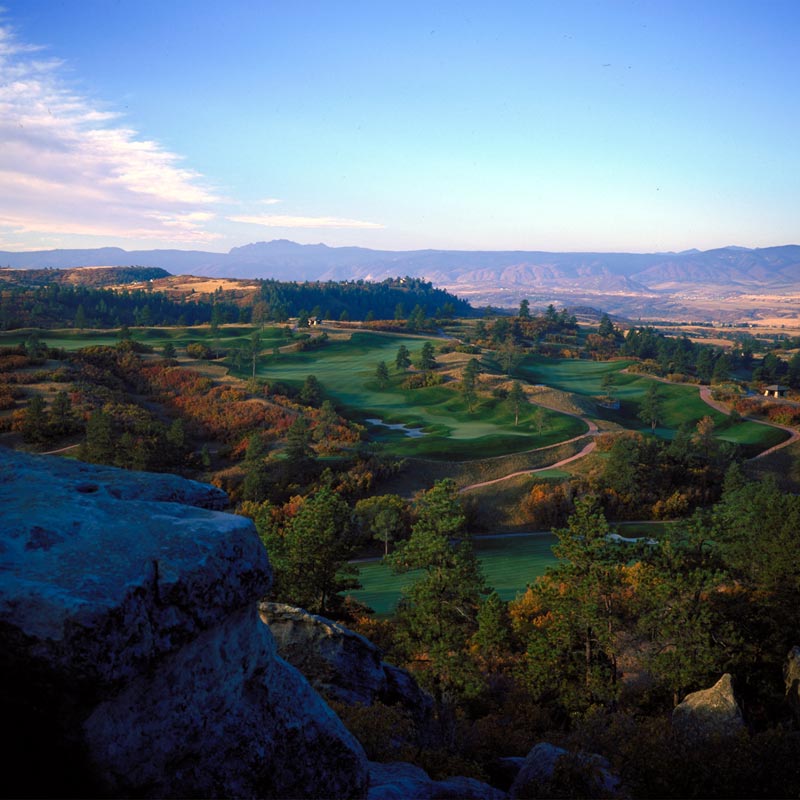
This aerial view shows the dramatic qualities of Sanctuary.
10. The 14th at Redlands Mesa is a short dogleg right two shotter that people either love or hate. Please describe it.
I have had more fun with the 14th hole at Redlands Mesa than just about any other golf hole that I have designed. It evokes passion in people. Most in favor, some not. Throughout the golf experience I feel that it is important to make sure people are paying attention. No. 14 does that. As a short par 4, this hole requires a tee shot through a gap created by large rock lined pinnacles just short of the intended landing area. If successfully negotiated into the landing area you are then faced with a 90-degree turn to the right into the green about 60 yards away. Should your tee shot fall short of, or into the gap, the green and flagstick become blind and your approach must carry over a multitude of rock outcroppings to reach the green. Fortunately, the shot is no more than 90 yards and is not as difficult as it appears.
The joy for me in creating a hole like the 14th at Redlands Mesa is that it is something that I have never before seen. I would assume that this would be the same for a large majority of players. Variety is beneficial to any experience. Certainly there has to be a point of no return for pushing the envelope in the name of variety. I feel that if a hole is playable and maintainable the envelope can be pushed to just about any limit.
The 14th addresses a very important issue for me. Tee selection. It is quite common to see 15 handicap golfers playing from the back tees where the approximate ability level is designed for players from 0 to 5. On this particular hole that typical 15-handicap player has very little chance of hitting through the gap to be rewarded with a site line to the green. Certainly this is unfortunate, but I will not lessen the golf experience/adventure for those that make poor decisions on tee selection. We have introduced the ‘Flex or Combination System’ of tee settings on most of our courses to help alleviate this situation.
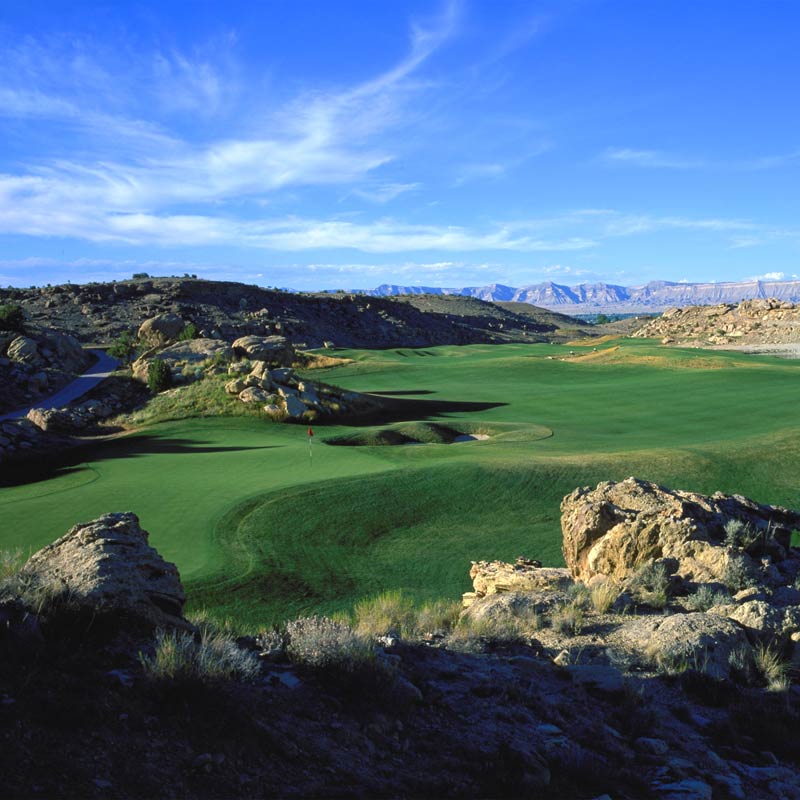
Looking back down the 14th at Redlands Mesa.
11. You take chances with your designs “ is there such a thing as fair vs. unfair criticism?
Yes I feel that I do take chances with different and interesting forms and spaces within a golf course. I am a great believer in making every hole with in a course have its own ‘very distinct and prominent personality / concept’ within each course. But it is also my goal to provide that variety with every hole that I design. The strong and sometimes ‘envelope pushing’ theme type holes are quite distinct and very recognizable. It is my goal to emboss the image of individual golf holes into your memory. Thus creating an entire golfing ‘experience’ with 18 holes. I like to call it an ‘adventure’. This may mean an aesthetic adventure or it may mean an adventure of shot making that you have never before experience. Truly I believe that it is an ‘art form of inter connected human experiences’. Golf is the only ‘ art form’ whereby the viewers of the art can not only move within the artwork but also ‘compete’ against it. That does not mean that I will paint the Mona Lisa on the flags to promote art. But I will give great consideration to the human spaces through which the game of golf is played.
Sometimes criticism comes from those that have not ‘experienced’ my work. I find that mindset difficult to understand.
12. Do you think you have a design trait that is misunderstood?
I choose to do things a little differently than some and certainly that has to be viewed as a good thing. If those of us working in the profession had the same interpretation or vision, the game would become very dull. I suppose I tend to look at golf as a gathering game as opposed to that of repelling the ball.
Bowls and gathering areas are quite fun to play. Does it make the course easier? Possibly but you must examine the situation. The more that you make a course playable, the more that you can ‘push the envelope’ with other unique elements. For example, if you would choose to create plateau greens that by their nature ‘repel’ shots away, the factor of difficulty is so great that it leaves very little room with which to push the envelope in other aspects of the design. I am a great believer that the art of putting is a separate game unto itself. That does not mean that it has to be brutally difficult, but I do choose to force players to use their imagination with putts that they do not often experience. When used as a green site, a bowl can provide for a great many ‘kick-ins’ onto the green. This will provide for many avenues of attack and allow the player to invoke some creativity into the game. If you choose to leave the rough longer many balls will hang up above the green and provide a very difficult ‘up and down’ situation. The aspect of unpredictability is interesting to me and it is at the core of the links style game. It is very easy to modify the difficulty of the course with these mowing patterns, possibly by as much as 6 strokes. Certainly I will design the course to play a certain way, but it is fun to tinker with that aspect through mowing patterns. Obviously it is important to have a variety of green styles. For example at Pradera we have six ‘bowled’ greens, six ‘plateau’ greens, and ‘six benched’ greens.
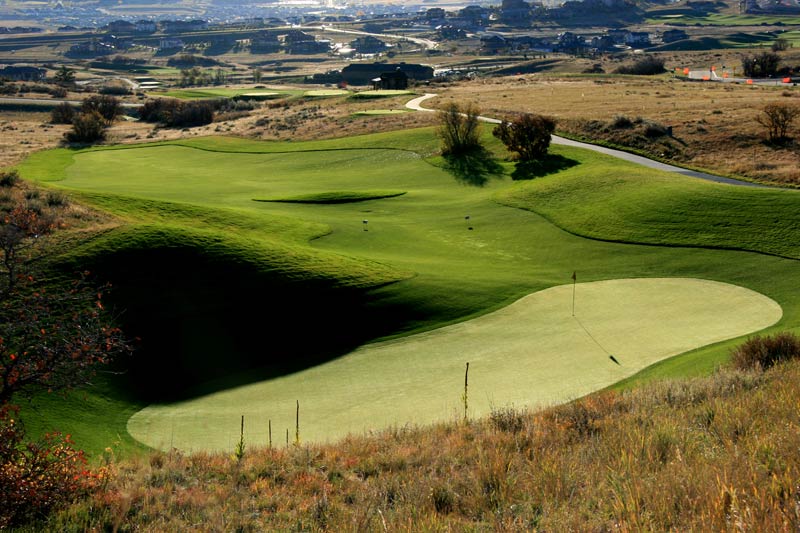
The Bowl 5th green at Pradera.The Plateau 13th green at Pradera.The 15th green benched into the hillside at Pradera.
At first glance my bunkers tend to appear to be very difficult to maintain. Actually, superintendents have discovered that when compared to the ‘flashing’ style bunkers it is easier to fly mow the steep faces of our bunkers once or twice a week (with growth regulators) than it is to rake and shovel sand back up the faces each morning. Aesthetically, I view my bunkers as strong or detailed points of visual accent. The long lines of most of our courses are complemented by the intricate detail of the bunkers, much in the same way that a touch of red adds to a visual domination of black. I feel that bunkers are called ‘hazards’ for a reason and from my perspective each individual bunker should not carry an ‘assigned penalty’. The randomness of nature or the ‘art of randomness’ should be a factor. In my bunkers you may have an option of playing a long iron if the ball rests in the long spine of the bunker. Yet two feet to the side, one must take the medicine and wedge back to the fairway.
Although the style and look of these bunkers has come from the same ‘family’ of bunkers they have evolved throughout my career and I am proud that they are relatively unique to the industry. When looking at history, you will see that many of the greats of the past had a defining bunker style that might evolve slightly but still come from a similar design concept. In many of the modern courses of today there is a tendency toward recreating the bunker styles of yesteryear. Certainly it is a wonderful look and has proven to be successful. However, with my bunker style, as well as my overall design style, I choose to avoid the temptation to re-create history and strive more toward creating my own piece of history.
It is one of my core beliefs that I do not want players to ‘get’ my courses the first time or even the tenth time that they play. I feel that the learning and discovery of a golf course over time not only makes it more interesting, but in fact forms an indescribable bond between course and player.
13. What are your thoughts on golf course rankings and how they do/don’t influence your profession?
I have been very fortunate to have done well in some of the rankings. Each of the major golf magazines has separate systems by which they judge courses. Understanding the detailed workings of each process might require a dual masters degree in psychology and math. I think Brad Klein was innovative in separating the modern and classical list. Golf Digest with Ron Whitten and Topsy Siderowf, expends an incredible amount of resources to evaluate the best new courses each year. Joe Passov is currently re-working the Golf Magazine system, a tremendous undertaking, and brings with him a wealth of experience and knowledge. Links Magazine and Travel & Leisure Golf both put in the time and effort to review new courses as well. Appreciation must also be shared with those panelists/raters that expend their own time and money to visit all of these courses. At the end of the day, all of these magazines and others are trying to define and judge an art form. As we know, art has neither a right or a wrong answer, just personal opinions and shades of grey.
The influence that these rankings have on the profession is enormous. They allow trained professional in the industry to compete with the living legends of the game, which ensures a quality and variety of product otherwise not attainable. Without such notoriety all of the golf courses of the world would be designed by the most famous of players. I dare say it is possible that theses rankings systems and the debate that they create may have inspired the creation of this web site.
The issue that to me seems most difficult to establish is that of tradition/aura/history/ influence. How does one differentiate between the qualities of the golf course as a ‘physical structure’ from that of a place of historical or social significance? Is a course ‘great’ because it has wonderful human spaces through which to play the game that we love or is it great ‘because it is great’? Most of the ratings have attempted to deal with this issue in a variety of ways. At the end of the day whenever you attempt to ‘judge’ anything using the unpredictability of human nature, the results will always be open to critique and conjecture. Therein lies the beauty of the rating systems. They create interest.
14. Fossil Trace is a great municipal course to the west of Denver, offering green fees of less than $50 to local residents. As opposed to most ho-hum municipal courses, Fossil Trace is rich with interesting design features, such as the long one shotter 14th with its vast green complex and the par 5 12th with its wild rocks pillars used as central fairway hazards. Would you have handled the design any differently if this was a private club course?
I am a great believer that necessity can be the mother of invention. The Fossil Trace site had so many very unusual constraints that it dictated thinking outside the box. For example the par 3 14th is a long uphill hole with an active irrigation ditch bisecting the hole. The ditch could not be lowered or moved to create vision from the tees below. The hillside where the green was placed would not allow for a normal sized green high enough to be visible. Therefore I created a Ëœfalse middle’ or 8 foot rise at 20% grade, which would allow for vision to the green surface. On top of the rise I placed a very small, single hole location, portion of green. This top shelf is obviously the toughest hole location. Typically, the hole will be placed in that location one time per week. At the base of the rise is a blind, Ëœmonster bowl’ that will gather the ball. This is an example of creating an intimidating look yet allowing players to accomplish the required shot. It is a rewarding feeling. The key to this situation is how the rough around the bowl is cut. During most public play days we will cut the turf at fairway height and promote fun, gathering golf. During high test tournament times we will allow the rough to grow higher and it will hold the ball on the hillside. That is a tough shot! By altering this practice throughout the season you can have a golf course that will be evolving constantly.
The pillars or fins on No. 12 were remnants of 100 years of clay mining. They allowed for an element that I had never before seen in that form. Essentially the mine site appeared to me to look like a random art form from the age of Dadaism that was popular in the early 1900’s. They were totally unique, random and without purpose. Yet in its own way it was very inspiring. It was that inspiration and uniqueness that I wanted to share within the golfing experience. Obviously, the key was to incorporate these features in a way that was functional and playable within the frame work of the game of golf. This was not a typical situation where I got to decide where to place things. It was more along the lines of determining which fins to remove thus leaving others standing. Essentially, I chose to remove the fins in the landing zones and keep them in the ball flight areas. This allowed for a significant Ëœintimidation factor’ yet provided a fair playing area.
The fins were basically long columns of solid rock that were sandwiched between the layers of soft clay. The uprising of the Rocky Mountains turned these layers vertical. The site was mined for the soft clay. That process resulted in the creation of the hard rock fins and pillars. Within and on the surface of these rocks are many fossils of plants and animals from 64 million years ago. The preservation of these fossils became a huge issue during the planning and construction process. In fact, had the golf course not been built within the mine, the fossils most likely would have been destroyed during the environmental clean-up. Today, the city has created walking paths within the golf course to allow the public to view these fossils.
When we were finally able to begin the detailed design process for Fossil Trace I had a long discussion with my client Charlie Fagan, the Parks and Recreation Director for the City of Golden, about the type of course that we should create. Ultimately, we both agreed that we should not hold back the creative spirit or dumb down the course because it was publicly owned. It was going to be about the experience. I have never regretted that decision and would not have changed a thing about Fossil Trace had it been a private course.
15. What were some of the obstacles facing you at Fossil Trace?
Fossil Trace opened in 2003. I did my first routing in 1991. We faced numerous challenges in those twelve years including land acquisitions, evolving routing plans and groups opposed to building a new golf course, including local and national pressure regarding the fossils. The site consisted of land parcels owned by the city, the county and the state but the key was obtaining the clay mine site, which was in the hands of a private owner. While the mine site had enormous potential for golf holes it also had been designated for an environmental clean-up. Fly ash, a hazardous by-product of the coal burning process, had been buried throughout the mine site for years. Our challenge was to find the fly ash, bury and cap it, and then build a golf course on top of it and all the while preserving the fossils. This situation required a tremendous amount of lateral thinking from both the design and construction teams. Wayne Metcalf with the golf course contractor American Civil Constructors took charge of the mine-site. To this day, I have never seen a finer job of golf course construction. I must also give great credit to Mitch Scarborough from my office for his work on Fossil Trace. Mitch is now my lead associate and valued confidant. Holes 11, 12, 13, 14, and 15 were built on the mine-site.
Some of the other difficulties that we faced were existing wetlands, over head power lines, flood water channels, gravity fed water canals and a tremendous amount of buried utilities and concrete structures from days past. In fact the chimney stack that I left in the middle of the first fairway was used to burn trash generated at an old prison facility. Part of that facility is still in use today as a juvenile detention center and the first four holes are routed around it. We also left most of the original mining equipment within the golf course. The ponds on holes 10, 16, 17 and 18 were designed for storm water detention, a necessity for approval of the project from Urban Drainage and which brought homes and businesses out of the flood plain.
The motto of Fossil Trace is ’64 million years in the making’. At the grand opening I reminded everyone that ‘only a million of it was in permitting, design and construction’.
16. Which holes were difficult to build yet turned out better than you expected at Fossil Trace?
All of the mine holes were difficult to build, but I would have say that the par 3, 11th hole is my favorite. The green is 200 ft. long by 30 ft. wide and it’s a little Ëœout there’ but really fun to play.
17. Please speak as to the opportunity of creating a second course for the Carne Golf Club in the extreme west of Ireland.
The third nine holes at Carne is a tremendous opportunity, as it will sit upon the most rugged land of the dunes of Carne. The fact that we must fit it within the routing of the existing Eddie Hackett course, with crossover areas, has presented some challenges. Nonetheless, I see the possibility of some of the most spectacular and cutting edge holes in golf. It has also been a wonderful opportunity to share the experience with my staff who have visited the site numerous times. I even managed to coax my good friend Forest Fezzler into a site visit to get his thoughts on the project.
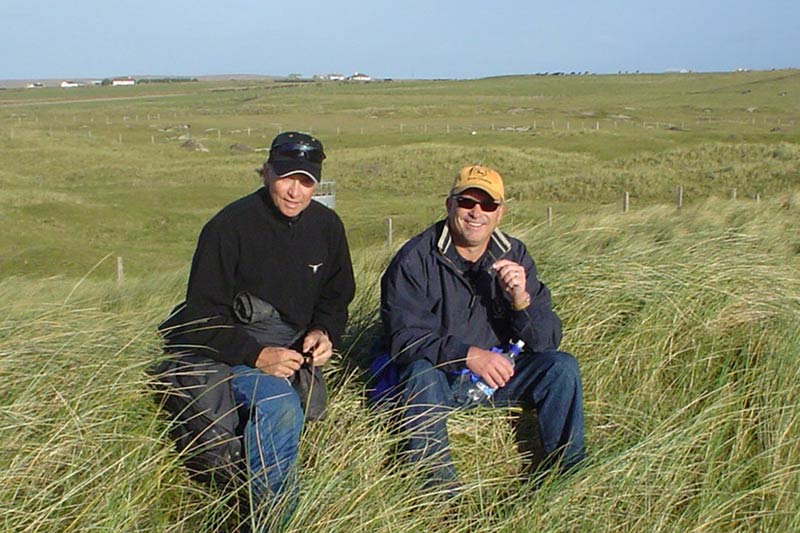
Forrest and Jim at Carne in western Ireland.
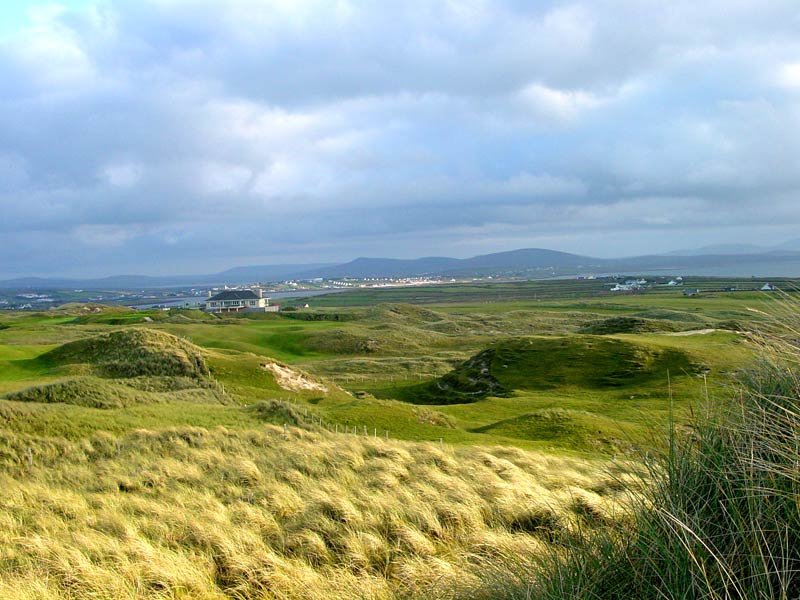
The thrilling property for the new nine at Carne Golf Club.
18. How have those trips to Ireland influenced your designs in the United States?
I fell in love with Carne in 2002. Quite frankly, it has taken some time to determine, in my own mind, just why I liked it so much. Certainly the massive and wild dunesland was a factor and the fact that the holes were borderline ‘silly’ made it interesting. However, the single element that has shown through in all of my favorite courses is the individual character of each hole. The best way that I can describe that thought is to compare Carne to Royal Portrush. Portrush is a fabulous course on really beautiful coastal links land. However, the land offered consistently similar land that in turn provided very similar golf holes. This left me with a bit of an incomplete experience. Conversely, Carne had individual hole character through many different types of landforms. Some hole went through the valleys formed by the dunes and others were in the ‘flats’ with wildly undulating fairway contours. I greatly preferred the Carne experience to that of Royal Portrush. Certainly, this idea of individual hole character is a major factor in the forming my core beliefs for working within my profession. Therefore I choose to bring back ‘bite sized pieces’ or ideas that I can then fit comfortably into the natural character of the land of a particular setting. The 10th hole at Pradera is an example of this concept. I chose several dominant elements to create a single and unique hole with a character all its own. The inspiration for the ‘dune ridge’ placed parallel to play in the landing area was an element that I saw at Castle Rock in Northern Ireland. The plateau green and twin sentinel bunkers on the short par 4 seemed to be a nice compliment to the ‘dune ridge’ concept. The ‘dune ridge’ at Castle Rock was much more massive than what was created at Pradera, which in many ways restricted play with balls rolling into the rough on either side. However, it was the ‘idea of an idea’ that promoted lateral thinking.
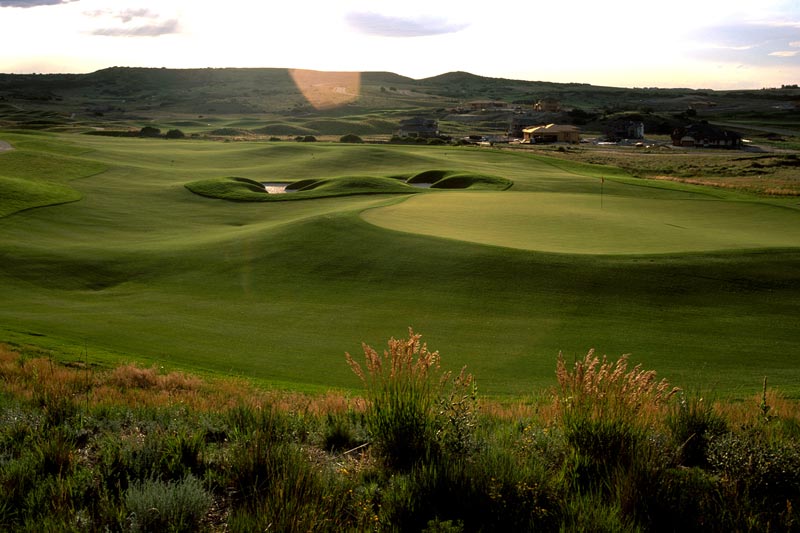
The 10th hole at Pradera
As the opportunity to work on natural dunesland might happen once in a career, it does not seem practical to me to try to recreate those dunes settings verbatim as an example, I have just finished the design for a project in Napa that we will break ground on in the spring. The sight is quite flat with a very high water table and an airport landing corridor that prohibits the creation of open water. My first inclination was to grade the 200 acres into dunes type setting without regard for the actual golf holes. The fun would begin in then finding the holes as they present themselves in the land. This approach greatly intrigued me. The fear that I had with this concept was with the repetition that would invariably occur with trying to replicate a links type setting. Although the look would be fascinating I felt that there was a possibility of creating holes that might carry uniqueness for a few holes but ultimately would become much to repetitive. In fact during this evaluation process I played a new course that was done in this theme. It confirmed in my mind that there was a lack of individual character to the holes.
19. Please describe a favorite hole at Pradera and what you like so much about it.
Certainly it is not uncommon to have a designated ‘favorite hole’ quietly in my mind before beginning construction. However, it is very rare that it is still my ‘favorite hole’ upon completion of the course and certainly after having played the course a few times.
I have really liked the 7th hole at Pradera from the first day and it continues to be my favorite today. A simple explanation is that it is a really fun par 5. Many options and strategies are available from the tee, landing areas and even within the putting surface. The real pleasure of the 7th is that it was a golf hole whereby very little was done to the land and was ‘found’ in its natural state. It is absolutely my preference to ‘find ‘ holes rather than ‘create’ them. What is difficult to understand is that individual ‘areas of interest’ will exist in nature, but having a site that provides for the exclusive use of ‘the totally naturally’ theory is possibly a once in a lifetime happening. Therefore I have adopted the theory of ‘bite size’ pieces within the natural character of any site.
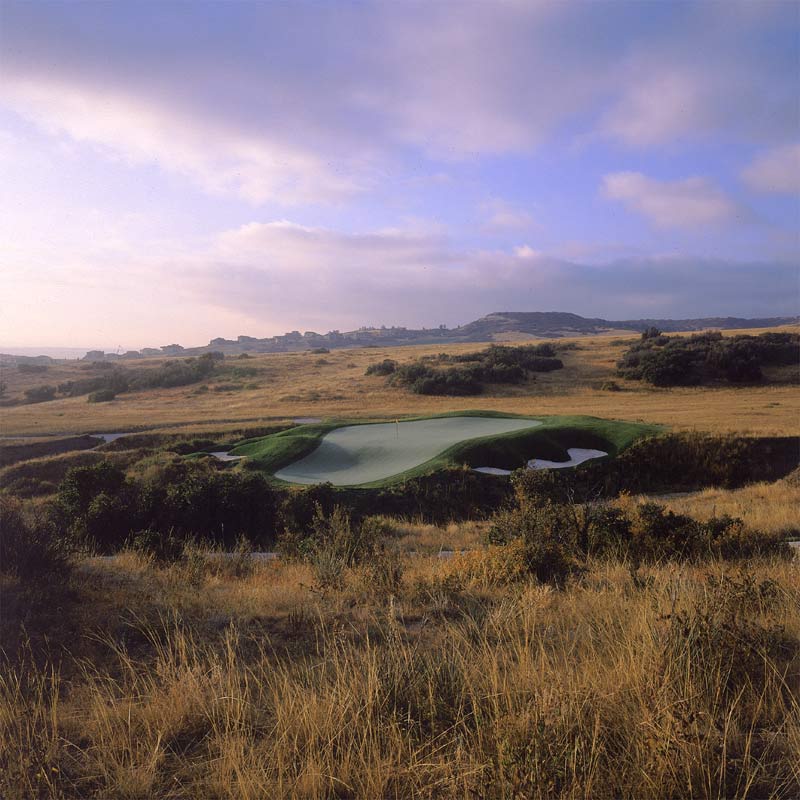
The bold 7th green at Pradera.
20. Would you say your style has evolved or changed much over the years? If so, how much and what is an example.
I have addressed my desire to make golf courses a fun experience and to my core belief that golf was invented as a ‘pastime’ by which to add enjoyment during a walk from the village, through the linksland, to jobs at the seashore. I choose to integrate my own interpretation of art with the playing of the game of golf to achieve that goal. Like it or not, those of us in the profession of golf course design are in the business of entertaining.
Golf began in the linksland of Scotland. It then grew to the heathlands of England and eventually to the coastal areas of America. Throughout the following century the game has moved to a wide variety of places in the US and to the rest of the world. Today we have an incredible array of golf course styles and settings that include desert courses, mountain courses, swampland courses, forested courses, prairie courses and every possible combination of theses courses. With all of these types of settings that nature has given to us the game of golf has flourished. Each and every one of these styles of golf courses must be respected and embraced if for no other reason than the simple values of variety to the human experience. If not then the wonderful settings through which we play the game of golf will become dangerously similar to the sterile environment of bowling. Keeping an ‘open mind’ to ‘all styles’ of golf courses is paramount to the success and growth of the game.
21. Lakota Canyon in western Colorado is on a severe but spectacular site. How do you weigh the pluses and minuses of spectacular and severe as it relates to building holes of good golf quality?
Lakota Canyon may have been the most physically challenging of the sites that I have worked on. The canyons and mountain sides were quite extreme. It was really a matter of finding areas where it was possible to build golf holes and then connect them into an 18 hole course. The land dictated that we put quite a few holes into the valley bottoms and then fill them up until we had a fairway that was of an appropriate width. The biggest factor was in dealing with the tremendous amount of drainage that would flow down the valleys during storms and runoff season. We used a combination of pipe and cart paths to convey the water. Everything considered, the things that made the site difficult were also the things that make the experience exciting. Lakota Canyon is one of those golfing experiences that is well outside the norm. Therein lays the beauty of the game of golf. With an open mind and an adventurous spirit the Ëœexperience’ opportunities are almost limitless.
22. What is required to make split fairway holes like the 18th at Lakota work?
Actually, the par 5, 18th at Lakota Canyon is not a split fairway. However, it feels very much like a split fairway with the aggressive line of play into the green on the second shot and with the safe play laying up to the right and away from the green.
Most often, existing land forms will dictate where a split fairway is possible and most effective. For example, the par 5, 7th hole at Pradera which features a split fairway, was kept in its natural form with only minor shaping required. It was simply a matter of finding the hole. On the other hand, the par 5, 18th at Pradera was totally created and fit within the required parameters of storm water detention for Douglas County. Both holes give you options on the tee that might be determined by hole location, wind, power, ability and ego. Just for the record, I would prefer to find golf holes rather than create them. However, that perfect site where every hole can be discovered, has yet to come my way. It is my job as a professional to create the best golf experience on the land that I am given. It is simply not in my nature to create a dull golf course just because I was given a dull site.
The End








